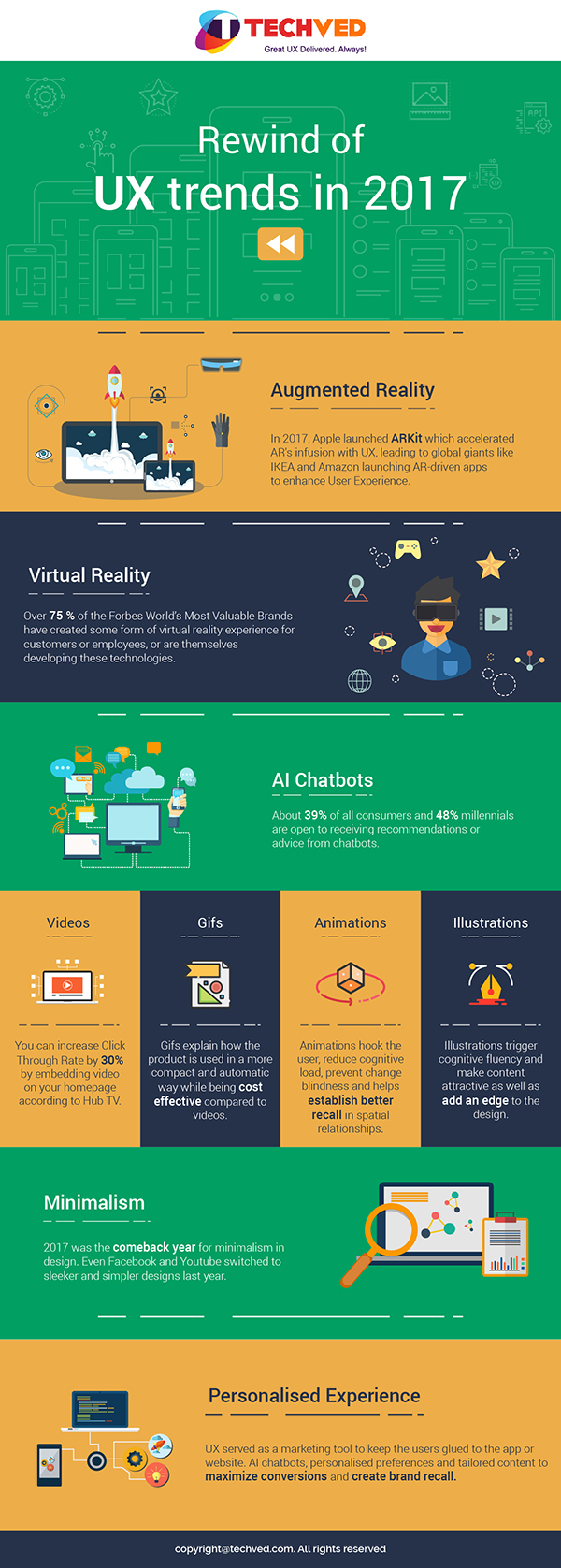Last year we observed a lot of trends in UX. New technologies emerged and infused with User Experience. New elements became prominent and a few old and forgotten ones resurged. As we begin another delightful year in UX, here’s a look back at all the things which made a splash in UX in 2017.

• Augmented Reality
Post the success of Niantic’s Pokémon Go in 2016 and the on-going appeal of Snapchat, AR has gained eminence in the field of UX. The launch of Apple’s AR framework ARKit last year facilitated the development of AR-powered apps and augmented reality (AR) became the biggest trend of 2017 in UX as global giants like Amazon, Ikea, Sephora, etc. launched their own AR apps to serve customers better. E-commerce is already looking at using AR to develop virtual trials and sampling rooms for items such as shoes, furniture, clothing, cosmetics, etc. The biggest companies from Silicon Valley have already begun investing heavily in AR technology. Facebook’s AR subsidiary Oculus has already invested heavily in over 11 AR and VR companies. The reason being that the projected growth of AR is extremely high. According to market research firm IDC, the global revenue for the augmented reality market and virtual reality market is set to hit $143 million by 2020. AR will continue to be the biggest influencer on UX in 2018 as well as more AR-driven apps hit the market.
• Virtual Reality
AR was not the only technology sweeping off UX in 2017. AR’s 3D sibling VR too gained influence on UX in 2017. Over 75 percent of the Forbes World’s Most Valuable Brands have created some form of virtual reality or augmented reality experience for customers or employees, or are themselves developing these technologies. With Microsoft, Intel, Google as well as Facebook have not only invested in VR but are also developing the technology themselves. VR has already become a success in the world of gaming. In 2017, the integration of such technologies that target the senses to provide an immersive user experience gained traction.
• AI Chatbots
2017 witnessed a lot of brand switching to AI Chatbots for client servicing. As the world itself moves on to digital communication from face-to-face interaction, AI Chatbots have become the need of the hour. A recent survey also found that about 63 percent of people would opt to enter into a conversation with chatbots while trying to connect with a business or a brand. Moreover, about 39 percent of all consumers, including 48 percent of millennials are open to receiving recommendations or advice from chatbots. This is why brands are moving to AI Chatbots. They have proven to be cost-effective and efficient and add to the user experience.
• Videos dominate homepages
Last year saw the rise of videos dominating homepage design. The addictive appeal of short videos that are dominating social media made an impression on design as well. Most brands, such as Adidas, Tesla, and Microsoft integrated short high definition videos on their homepage. According to Hub TV, you can increase Click Through Rate by 30% by embedding video on your homepage. Therefore, this trend from 2017 is set to continue in 2018 as well.
• GIFs
While videos did dominate the homepage, GIFs too made a splash. Gifs explain how the product is used in a more compact and automatic way while being cost-effective compared to videos. This makes them perfect as an explanatory tool along the user’s journey. Having a visual aid in the form of GIFs guides the user in the right direction. This is why 2017 saw GIFs being used in webpages and apps. Moreover, given they are more cost-effective than videos, GIFs also made their way on homepages in 2017.
• Animations
A trend from 2016, animations continued to be popular in 2017 as well. Functional animation helps in reducing cognitive load, prevent change blindness and helps establish better recall in spatial relationships. Also, animations have a visual appeal that hooks the user’s attention and directs it. Animations are attractive and catchy which is why users like it.
• Illustrations
Videos, GIFs and animations grab our attention using motion while illustrations get the job done without it. Illustrations add a hint of personalization to the design. They also serve as a way to establish the brand. Illustrations represent text visually making it easier for the user. Illustrations trigger cognitive fluency and make content attractive as well as add an edge to the design.
• Minimalism
Some things never go out of style and minimalism in design is certainly one of them. Minimalism made a comeback in 2017 as the demand for sleeker design along with plenty of white space and a leaner approach. Last year saw designers use simplicity and elegance to make designs aesthetically pleasing. Even Facebook and YouTube opted for a minimalistic approach to reduce cognitive load and communicate information clearer.
• Personalised Experience
With technology like AR, VR, and AI Chatbots evolving so rapidly in 2017, brands are now using UX to provide a more personalized experience to their users. UX serves as a marketing tool to keep the users glued to the app or website. AI chatbots, personalized preferences and tailored content are being used to maximize conversions and create brand recall. This trend will continue to follow through 2018 as well.
A lot of the abovementioned trends will continue to drive User Experience in 2018 as well. Along the way, some new trends will emerge too. Here’s to another trendy year in UX!